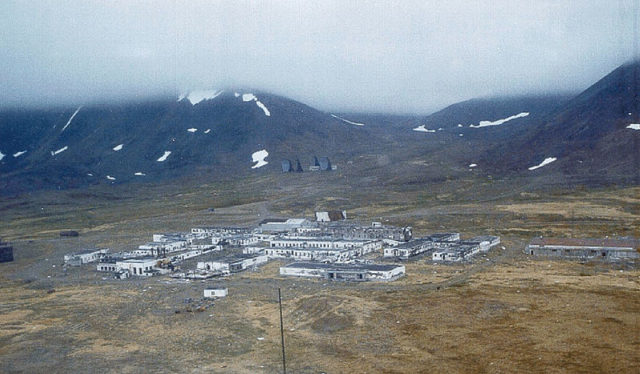
The St Lawrence Island site. Author: U.S. Army Corps of Engineers Digital Visual Library (via Abandoned Spaces)
Many thanks to SWLing Post contributor, Steven Crawford, who writes:
Came across this article about a communications system that was a precursor to sat comms for the Air Force and thought it may be of interest to your followers.
(Source: Abandoned Spaces)
Equipped with up to 80 radio stations, this remnant of the Cold War once served as a tropospheric scatter communications system using microwave relay. Its location, Alaska. It was initially constructed during the 1950s.
The United States Air Force saw great benefit from this communication system for it improved their communication tremendously. Years before this system was installed, Alaska had only the essentials when it came to communication systems.
It wasn’t until Bell Systems came up with their design for the U.S.A.F. that Alaska would receive proper communications links. The name White Alice Communications System in itself is an acronym made up of the following words – White, for it was used in the snow-covered land of Alaska, and Alice, that stands for Alaska Integrated Communications and Electronics.[…]
Many thanks for sharing this, Steven!

The US Army used such systems quite often. I remember such large dishes from the 1970s here in Germany, for exanple in Frankfurt. In Frankfurt they had them in several directions.
The dishes here were always in pairs. I think one was for transmitting and one for receiving. The oscillators and power ampliefiers of that time had quite high wideband noise floors so duplexers gave not enough separation and attenuated the signals. I know that the developers of the first 2m FM repeaters in the late 1960s also suffered from this problem.
As it has happend more often, commercially abandoned technology lives on in Ham Radio. One such technology is Morse code. Another is Troposcatter: Using enough transmitting power and antenna gain, a single narrow-band channel can be opened.
* Big stations in southern Germany and northern Italy can work each other nearly all the time across the Alpes on 2 m SSB. You need several 100 W of RF power and a 20 dBi antenna for that.
* A newer development: With 20 W of RF and an 1-2 m Dish on 10 GHz you can communicate across several 100 km. The biggest problem here is frequency stability while surplus 10 GHz power amplifiers are quite cheap. Most of these stations use a GPS-controlled time base.
For dishes to be effective they need a diameter of at least 10 wavelengths. You also need to consider that the ambient noise lowers at higher frequencies. And finally, receiver sensitivity got better to breathtaking hghts. When SAT TV was introduced, 2-4 m dishes were needed at the receiving end. This is one of the causes why large TV cable systems were built in the 1970s and 1980s.
Today TV dishes only need a small fraction of that size, mostly due to the low-noise receivers (LNA). The satellite output power per channel was hardly increased over the time – on the contrary.
And we in Europe had our network. ACE High was the name. Operated by NATO the Tropo circuit was from Norway via the Faroe Islands and onwards to Turkey.
Here are some links which give info:
http://www.subbrit.org.uk/rsg/features/ace_high/
http://www.subbrit.org.uk/rsg/features/ace_high/index4.html
http://www.subbrit.org.uk/rsg/features/ace_high/index5.html
http://www.subbrit.org.uk/rsg/features/ace_high/index1.html
http://www.subbrit.org.uk/rsg/features/ace_high/index2.html
Of course the 900 MHz band used for these links are now no longer available. Well, we’ve all got GSM mobile phones (sorry, US: cell phones) using the bandwidth..